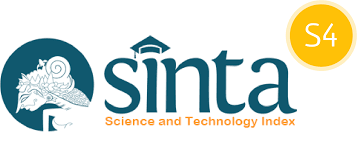Uji Viabilitas Polen Tanaman Kedelai (Glycine max (L.) Merril) pada berbagai Lama Penyimpanan
Abstract
Pollen can be used for plant identification because it has a distinctive structure and ornamentation, besides that it can also be used as a plant breeding agent as a contributor to male parental characters. The character of pollen as parental male is very important in plant breeding. One way to know the quality of pollen is to look at its viability. Pollen viability can be tested by staining method or by germination method. Pollen viability is known to be lost over a certain period of time. The purpose of this study was to determine the effect of storage time on viability of soybean pollen, and to determine the best storage period with the highest viability of soybean pollen. This research was conducted experimentally with a Completely Randomized Design (CRD) consisting of 4 treatments, namely P0, Control. P1, 7 days of storage. P2, 14 days of storage. P3, 21 days of storage. The independent variable is variation in storage time while the dependent variable is pollen viability. The parameters observed were the number of stained pollen, germination capacity, and the length of the germinating pollen tube as evidence that the pollen was viable. The research data obtained were analyzed using Analysis of Variance (ANOVA) with an error rate of 5%, then continued with the BNT test with an error rate of 5%. The results showed that the provision of storage time treatment on soybean pollen had an effect on pollen viability, namely by reducing pollen viability. The best shelf life to get the highest pollen viability in soybean pollen is 0 to 7 days after the sample is taken.
References
Anitasari, S. D., Astarini, I. A., Defiani, M. R., Pharmawati, M., & Prayantini, D. C., 2019. Pollen Viability and Microspore Culture in Three Broccoli Cultivars (Brassica oleracea L. var. italica Plenck). Jurnal Biota, 5(2), pp.118-127.
Anitasari, S. D., Winingsih, A. R., Waris, W., Sari, D. N. R., Astarini, I. A., & Defiani, M. R., 2018. Pengaruh Variasi Media Terhadap Viabilitas Pollen Tanaman Tebu (Saccharum Sp.). In Prosiding Seminar Nasional SIMBIOSIS. Jember, 2018.
Astawan, M., & Hazmi, K., 2016. Karakteristik Fisikokimia Tepung Kecambah Kedelai. Jurnal Pangan, 25(2), pp.105-112.
Azizah, N., Suedy, S. W. A., & Prihastanti, E., 2016. Keanekaragaman Tumbuhan Berdasarkan Morfologi Polen dan Spora dari Sedimen Telaga Warna Dieng, Kabupaten Wonosobo, Jawa Tengah. Buletin Anatomi dan Fisiologi dh Sellula, 24(1), pp.66-75.
Brewbaker, J. L., & Kwack, B. H., 1963. The Essential Role of Calcium Ion in Pollen Germination and Pollen Tube Growth. American Journal of Botany. 50(9), pp.859-865.
Devitasari, R., 2004. Fertilitas dan Kompatibilitas Persilangan pada Empat Varietas Unggul Lokal Durian (Durio zibethinus Murr.). Skripsi. Malang: Jurusan Budidaya Pertanian Universitas Brawijaya.
Djanaguiraman, M., Prasad, P. V., Boyle, D. L., & Schapaugh, W. T., 2013. Soybean Pollen Anatomy, Viability and Pod Set Under High Temperature Stress. Journal of Agronomy and Crop Science, 199(3), pp.171-177.
Gibernau, M., Macquart, D., & Diaz, A., 2003. Pollen Viability and Longevity in Two Species of Arum italicum and A. aculatum. Aroideana, 26, pp.58–62.
Hasrianda, E. F., Zaelani, A., & Poerba, Y. S., 2020. Jumlah, Uji Viabilitas dan Daya Kecambah Polen 31 Aksesi Pisang (Musa sp.) Koleksi Kebun Plasma Nutfah Pisang Lipi. Berita Biologi, 19(2), pp.197-206.
Hersuroso, I., Suharyo, Santoso, S. Hastjarjo, & Y. Faswani., 1984. Panduan Kebun Induk Kelapa Hibrida. Medan: Pusat Penelitian Kelapa.
Kavand A., A. Ebadi, Y. D. Shuraki, & V. Abdosi., 2014. Effect of Calcium Nitrate and Boric Acid On Pollen Germination of Some Date Palm Male Cultivars. European Journal of Experimental Biology, 4(3), pp.10–14.
Kuntyastuti, H., & Taufiq, A., 2014. Komponen Teknologi Budidaya Kedelai di Lahan Kering. Buletin Palawija, (16), pp.1-17.
Nirmala, S., Kriswiyanti, E., & Darmadi, A. K., 2013. Uji Viabilitas Serbuk Sari Secara In-Vitro Kelapa (Cocos nucifera L.“Rangda”) Dengan Waktu dan Suhu Penyimpanan Yang Berbeda. Jurnal Simbiosis, 1(2), pp.59-69.
Oliveira, W., e Silva, J. L. S., de Oliveira, M. T. P., Cruz-Neto, O., da Silva, L. A. P., Borges, L. A., & Lopes, A. V., 2019. Flowering and Fruiting Synchronization, Pollen Number, Floral Visitors and Reproductive Success of Paubrasilia echinata (Brazilwood; Leguminosae) in Tropical Urban Ecosystem in Comparison to Atlantic Forest Remnant: A dataset. Data in brief, 25, 104177.
Patel E., & A. Mankad., 2015. Sucrose Needs for Pollen Germination of Impatiens Balsamina L. International Journal of Innovative Research in Sci, Eng. and Tech. 4(10), pp.10242–10244.
Permadi, G. S., 2015. Analisis Permintaan Impor Kedelai Indonesia. Eko-Regional: Jurnal Pembangunan Ekonomi Wilayah, 10(1), pp.23-31.
Perveen, A., 2007. Pollen Germination Capacity, Viability and Maintanence of Pisium sativum L (Papilionaceae). Middle-East Journal of Scientific Research 2, pp.79–81.
Pillay, M., & Tenkouano, A., 2011. Banana Breeding: Progress and hallenges. Boca Raton, FL, USA: CRC Press.
Pratiwi, W., Kuswanto, K., & Purnamaningsih, S. L., 2017. Studi Viabilitas Polen Melalui Silang Diri Pada Tiga Genotipe Tanaman Kecipir (Psophocarpus Tetragonolobus). Jurnal Produksi Tanaman, 5(3), pp.425-432.
Putra, A. D., Siti, Z., & Heru, K., 2017. Karakterisasi Pollen Plasma Nutfah Kedelai (Glycine max L. Merril). Seminar Nasional Pendidikan Sains. Surakarta, 2017.
Rahmawati, D., & Prayitno., 2013. Viabilitas Polen Cabai Keriting (Ck004) Pada Berbagai Kombinasi Pengeringan dan Lama Penyimpanan. Jurnal Ilmiah Inovasi, 13(3), pp.213-216.
Ridha, R., 2016. Uji Viabilitas Polen Beberapa Varietas Padi (Oryza sativa L.) Introduksi. Jurnal Penelitian Agrosamudra, 3(2), pp.81-89.
Samiyarsih, S., Fitrianto, N., Rohma, A., & Sasongko, N. D., 2020. Profil Mikromorfologi Kecipir (Psophocarpus tetragonolobus (L.) DC) Mutan Akibat Iradiasi Sinar Gamma Cobalt-60. PLANTROPICA: Journal of Agricultural Science, 5(2), pp.95-206.
Samudra, P. C., & Herawati, M. M., 2020. Pengaruh Suhu dan Lama Simpan Terhadap Viabilitas Polen Petunia (Petunia Inflata). Jurnal Penelitian Pertanian Terapan, 20(2), pp.135-141.
Shivanna, K. R., Linkens, H. F. & Cresti, M., 1991. Pollen Viability and Pollen Vigor. Theor. Appl. Genet. 81, pp.38-42.
Tambunan, I. R., & I. Mariska., 2003. Pemanfaatan Teknik Kriopreservasi dalam Penyimpanan Plasma Nutfah Tanaman. Buletin Plasma Nutfah, 9(2), pp.10-18.
Ulfah, S. M., Dorly, & Rahayu, S., 2016. Perkembangan Bunga dan Uji Viabilitas Serbuk Sari Bunga Lipstik Aeschynanthus radicans var.'Monalisa'di Kebun Raya Bogor. Buletin Kebun Raya, 19(1), pp.21-32.
Warid, & Palupi, E. R., 2009. Korelasi Metode Pengecambahan In Vitro dan Pewarnaan dalam Pengujian Viabilitas Polen. Skripsi. Jurusan Agronomi dan Holtikultura Fakultas Pertanian. Institut Pertanian Bogor. Bogor.
Winarto, B., & Rachmawati., 2007. Teknik Kultur Anther Pada Pemuliaan Anthurium. Jurnal Hortikultura, 17(2), pp.127-137.














_copy.png)



